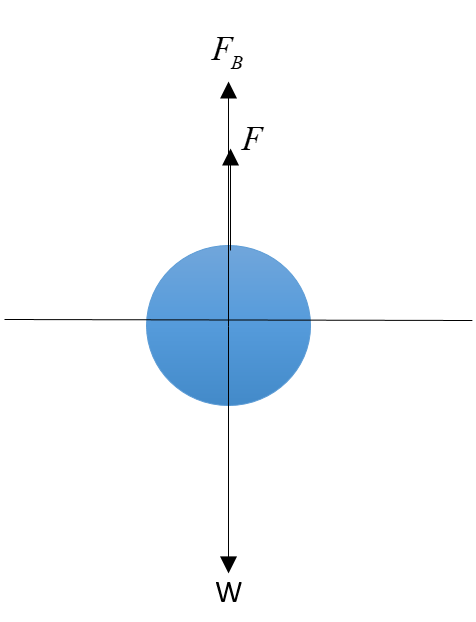
A drop of liquid of density $\rho$ is floating half immersed in a liquid of density ‘d’. If $\sigma$ is the surface tension, then what is the diameter of the drop of the liquid?
$\text{A.} \sqrt{\dfrac{3\sigma}{g(2\rho-d)}}$
$\text{B.} \sqrt{\dfrac{6\sigma}{g(2\rho-d)}}$
$\text{C.} \sqrt{\dfrac{4\sigma}{g(2\rho-d)}}$
$\text{D.} \sqrt{\dfrac{12\sigma}{g(2\rho-d)}}$
Answer
566.4k+ views
Hint: Surface tension: It is the property of liquid by the virtue of which the surface of the liquid acts as a stretched membrane. In other words, the surface wants to minimize its area and hence when a body is kept on a liquid, liquid exerts a force on the touching boundary of the liquid and the body and also when a body is fully or partially immersed in a liquid, it experiences an upward force of buoyancy.
Formula used:
$F = Tl,\ F_B = dVg$
Complete step by step answer:
When we place something in a liquid, either it sinks or it floats. Every fluid exerts an upward force on objects lying inside it. This upward force is known as buoyant force or the force of buoyancy. The magnitude of this force depends only upon the density of liquid. If this force is more than the weight of the object, it will float and if the force is less than the weight of the object, it will sink. Now, as the drop is half immersed in the liquid, the force of buoyancy acting on it will be:
$F_B = gd(\dfrac12 \times \dfrac43\pi r^3) = \dfrac23 d\pi gr^3$
Now, force due to surface tension is given by:
$F = Tl = \sigma \times 2\pi r$
Since the drop is in equilibrium, the net force on the liquid is zero. Hence the weight of the drop must be balanced by the force of buoyancy and surface tension.

i.e. $W = F+F_B$
Now, weight W = mg = $\rho Vg$
Hence putting the values, we get;
$\rho Vg = 2\sigma \pi r + \dfrac23d\pi gr^3$
Also $V = \dfrac43\pi r^3$
$\implies \rho \dfrac43\pi r^3 g= 2\sigma \pi r + \dfrac23 d\pi gr^3$
$\implies \rho \dfrac43\pi r^3 g- \dfrac23 d\pi gr^3= 2\sigma \pi r$
$\implies 2\sigma \pi r=\dfrac23 \pi g r^3 \left( 2\rho - d\right)$
$\implies \sigma =\dfrac13 g r^2 \left( 2\rho - d\right)$
$\implies r^2 = \dfrac{3\sigma}{g(2\rho-d)}$
$\implies r = \sqrt{\dfrac{3\sigma}{g(2\rho-d)}}$
Thus, option A. is correct.
Note:
Due to the property of surface tension, the block will experience some force which is given by formula: $F = Tl$. Here, T is the surface tension and ‘l’ is the length of the object which is in contact with the fluid. Length in the sense the perimeter of the boundary which is the interface of both air and fluid.
Formula used:
$F = Tl,\ F_B = dVg$
Complete step by step answer:
When we place something in a liquid, either it sinks or it floats. Every fluid exerts an upward force on objects lying inside it. This upward force is known as buoyant force or the force of buoyancy. The magnitude of this force depends only upon the density of liquid. If this force is more than the weight of the object, it will float and if the force is less than the weight of the object, it will sink. Now, as the drop is half immersed in the liquid, the force of buoyancy acting on it will be:
$F_B = gd(\dfrac12 \times \dfrac43\pi r^3) = \dfrac23 d\pi gr^3$
Now, force due to surface tension is given by:
$F = Tl = \sigma \times 2\pi r$
Since the drop is in equilibrium, the net force on the liquid is zero. Hence the weight of the drop must be balanced by the force of buoyancy and surface tension.

i.e. $W = F+F_B$
Now, weight W = mg = $\rho Vg$
Hence putting the values, we get;
$\rho Vg = 2\sigma \pi r + \dfrac23d\pi gr^3$
Also $V = \dfrac43\pi r^3$
$\implies \rho \dfrac43\pi r^3 g= 2\sigma \pi r + \dfrac23 d\pi gr^3$
$\implies \rho \dfrac43\pi r^3 g- \dfrac23 d\pi gr^3= 2\sigma \pi r$
$\implies 2\sigma \pi r=\dfrac23 \pi g r^3 \left( 2\rho - d\right)$
$\implies \sigma =\dfrac13 g r^2 \left( 2\rho - d\right)$
$\implies r^2 = \dfrac{3\sigma}{g(2\rho-d)}$
$\implies r = \sqrt{\dfrac{3\sigma}{g(2\rho-d)}}$
Thus, option A. is correct.
Note:
Due to the property of surface tension, the block will experience some force which is given by formula: $F = Tl$. Here, T is the surface tension and ‘l’ is the length of the object which is in contact with the fluid. Length in the sense the perimeter of the boundary which is the interface of both air and fluid.
Recently Updated Pages
Why are manures considered better than fertilizers class 11 biology CBSE

Find the coordinates of the midpoint of the line segment class 11 maths CBSE

Distinguish between static friction limiting friction class 11 physics CBSE

The Chairman of the constituent Assembly was A Jawaharlal class 11 social science CBSE

The first National Commission on Labour NCL submitted class 11 social science CBSE

Number of all subshell of n + l 7 is A 4 B 5 C 6 D class 11 chemistry CBSE

Trending doubts
What is meant by exothermic and endothermic reactions class 11 chemistry CBSE

10 examples of friction in our daily life

One Metric ton is equal to kg A 10000 B 1000 C 100 class 11 physics CBSE

1 Quintal is equal to a 110 kg b 10 kg c 100kg d 1000 class 11 physics CBSE

Difference Between Prokaryotic Cells and Eukaryotic Cells

What are Quantum numbers Explain the quantum number class 11 chemistry CBSE




